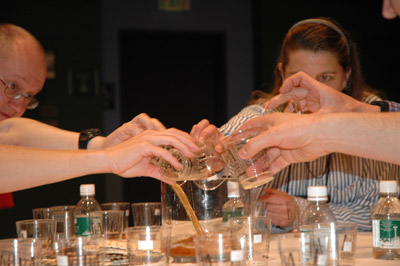 We watched enough basketball over the weekend that once in a while we didn’t manage to hit mute when a commercial came on.
We watched enough basketball over the weekend that once in a while we didn’t manage to hit mute when a commercial came on.
Thus I finally heard the words that accompany the footage where Miller Brewing employees hoist a banner celebrating Miller Lite’s victory in the 2006 World Beer Cup. The banner hangs beside several others.
Viewers learn that 2,221 beers from 540 breweries were judged in the World Beer Cup.
Should I think that Miller Lite was judged better than any other? If I didn’t know better I might have gone back to basketball with that impression.
In fact, Lite beat out 21 other beers to win American-Style Light Lager. This is no small accomplishment. Half the beer sold in the United States fits in this category. It’s not easy to make. As beer judges will tell you, “There’s no place to hide.” Flaws are easy to spot. For instance, winning that category was probably just as hard as capturing gold in European-Style Pilsener (61 entries).
Miller also brewed the second-place light beer, Lone Star Light, under contract.
I hope I’m not just picking on Miller. If you listen to the words that come after 2,221 beers, 540 breweries, etc. the narrator clearly says Miller won the light category. Just not, “There were 22 beers in our category.”
So give them credit for promoting the World Beer Cup. Perhaps viewers will Google the results and learn that a small brewery nearby also won a medal. Give them credit for shooting a commercial right there in the brewery, hanging those banners and being proud of their beer.
Just don’t hear those numbers – 2,221 beers, 540 breweries – and think they were all competing for the same banner.
